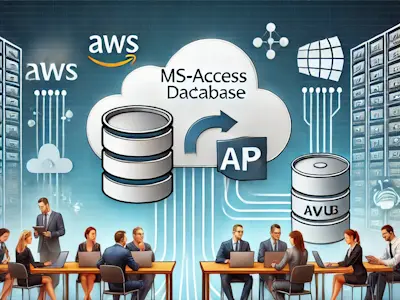Latest News
 Sunday, March 16, 2025
Sunday, March 16, 2025As businesses continue to evolve, so should your technology. If your company is still relying on an MS-Access database, now is the time to upgrade. With Antrow Software, you can seamlessly convert MS-Access into a Web App and run it in the cloud for enhanced efficiency, accessibility, and security.
? Access Your Data Anywhere, Anytime – Work from any device without limitations.
? Run MS-Access in the Cloud – Eliminate server dependency and reduce IT maintenance costs.
? Scalability & Security – Protect your data while ensuring your system grows with your business.
? Seamless Migration – Our team ensures a smooth transition with minimal downtime.
Migrating to a cloud-based Web App is not just about modernization—it’s about staying ahead of the competition and ensuring your business is future-ready.
?? Contact us today to discuss how Antrow Software can help you upgrade your MS-Access system into a high-performance Web App running on AWS, Azure, or your preferred cloud provider.
?? Learn more: antrow.com
Best regards,
The Antrow Software Team
#MSAccessToWebApp #RunMSAccessInTheCloud #CloudMigration #BusinessEfficiency #AntrowSoftware

Customer stories
 Monday, February 27, 2023Author: Antrow Software
Monday, February 27, 2023Author: Antrow SoftwareJohn is the owner of a small manufacturing company that has been using Microsoft Access as their primary database management system for many years. However, the system has become outdated, difficult to manage, and lacks the necessary features to keep up with the company's growth. John knows that he needs to modernize the system to improve efficiency, productivity, and profitability.
After conducting extensive research, John comes across Antrow.com and discovers that they specialize in converting Microsoft Access databases into modern, cloud-based web applications. John decides to contact Antrow.com to learn more about their services.
Upon contacting Antrow.com, John is assigned a dedicated project manager who works closely with him to understand the company's specific needs and requirements. The project manager evaluates the existing Microsoft Access database, proposes a customized solution, and provides a detailed project plan and timeline.
Antrow.com's team of experienced developers then starts working on the project, converting the Microsoft Access database into a modern, cloud-based web application. The new application is secure, scalable, and user-friendly, with robust features and functionalities to meet the company's specific needs.
After the project is completed, Antrow.com provides John with comprehensive training on how to use the new system and ongoing support and maintenance to ensure that the system continues to meet the company's needs.
Thanks to Antrow.com's MS-Access to Web App Conversion service, John's manufacturing company now has a modern, efficient, and productive database management system that enables them to keep up with their growth and achieve greater success.

Latest articles
 Sunday, February 19, 2023Author: Antrow Software
Sunday, February 19, 2023Author: Antrow SoftwareMicrosoft Access, or simply Access, is a relational database management system developed by Microsoft. It was first released in November 1992 as a part of the Microsoft Office suite, and has since then gone through several major versions, with the latest being Access 2019, released in 2018.
The idea for Access began in the late 1980s, when Microsoft realized that many of its customers were using Excel spreadsheets to store and manage data. However, spreadsheets were not well-suited for managing large amounts of data, and customers were asking for a more robust solution. In response, Microsoft formed a team to develop a new database management system that would be easier to use than existing products on the market, such as Oracle and SQL Server.
The team was led by Alan Cooper, who had previously created the popular programming language Visual Basic. The first version of Access was released in 1992, and it was an immediate success. Access was a more user-friendly database management system than its competitors, and it quickly became popular among small businesses and non-technical users who needed a way to manage their data without relying on IT departments.
Over the years, Access has undergone many changes and improvements. In the late 1990s, Microsoft introduced a new database format called Access Data Project (ADP), which allowed Access to connect to SQL Server databases. This gave Access users the ability to create powerful client-server applications, and it helped to position Access as a more serious database management system.
In the early 2000s, Microsoft introduced a new version of Access, called Access 2002 (also known as Access XP), which included a number of new features, such as the ability to create data access pages that could be published to the web. Access 2003, released in 2003, introduced a new interface that made it easier to work with complex databases.
In recent years, Microsoft has continued to update Access with new features and capabilities. Access 2010, released in 2010, introduced a new feature called "Web Databases," which allowed users to create databases that could be published to the web using SharePoint. Access 2013 introduced a new app model, which allowed users to create and deploy Access web apps to SharePoint Online, and Access 2016 introduced several new features aimed at improving the user experience and making it easier to work with data.
Despite the rise of other database management systems like MySQL and PostgreSQL, Access remains a popular tool for small businesses and non-technical users who need a simple way to manage their data.